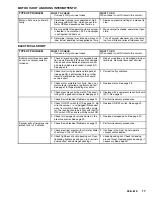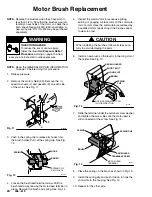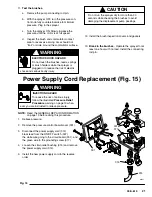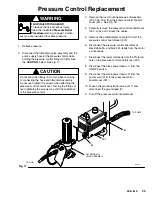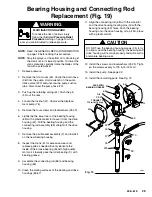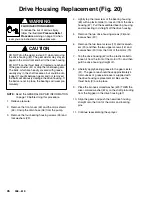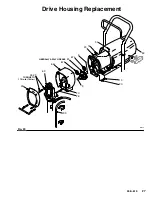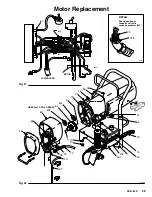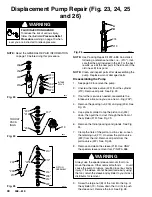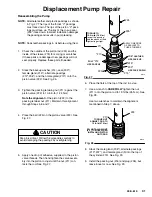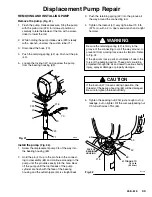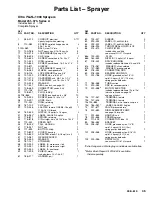
Motor Brush Replacement
NOTE:
Replace the brushes when they have worn to
less than 1/2 in. Note that the brushes wear dif-
ferently on each side of the motor, so check them
both. Brush Repair Kit 220–853 is available. A
new spring clip, P/N 110–816 may be purchased
separately.
WARNING
INJECTION HAZARD
To reduce the risk of serious injury,
follow the illustrated
Pressure Relief
Procedure
warning on page 13 when-
ever you are instructed to relieve pressure.
NOTE:
Read the GENERAL REP AIR INFORMATION
on page 19 before doing this procedure.
1. Relieve pressure.
2. Remove the motor shield (59). Remove the in-
spection covers (J) and gaskets (K) on each side
of the motor. See Fig. 11.
J
F
59
Fig. 11
01224A
3. Push in the spring clip to release its hooks from
the brush holder. Pull out the spring clip. See Fig.
12.
Fig. 12
BRUSH
SPRING CLIP
P/N 110–816
HOOK
SPRING
01227
4. Loosen the brush lead terminal screw. Pull the
brush lead away, leaving the motor lead terminal in
place. Remove the brush and spring. See Fig. 14.
5. Inspect the commutator for excessive pitting,
burning or gouging. A black color on the commuta-
tor is normal. Have the commutator resurfaced by
a qualified motor repair shop if the brushes seem
to wear too fast.
CAUTION
When installing the brushes, follow all steps care-
fully to avoid damaging the parts.
6. Install a new brush so the lead is in the long slot of
the holder. See Fig. 13.
Fig. 13
BRUSH
SHORT SLOT
LONG SLOT
BRUSH HOLDER
NOTE: SPRING MUST COIL
IN THIS DIRECTION
SPRING
CLIP
01227
7. Slide the terminal under the terminal screw washer
and tighten the screw. Be sure the motor lead is
still connected at the screw. See Fig. 14.
Fig. 14
SPRING
BRUSH LEAD
TERMINAL SCREW
MOTOR LEAD
TERMINAL
BRUSH
SPRING CLIP
01227
8. Place the spring on the brush as shown in Fig. 13.
9. Install the spring clip and push it down to hook the
short slots in the housing. See Fig. 13.
10. Repeat for the other side.












